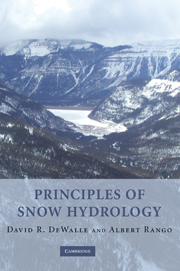Book contents
- Frontmatter
- Contents
- Preface
- 1 Introduction
- 2 Snow climatology and snow distribution
- 3 Snowpack condition
- 4 Ground-based snowfall and snowpack measurements
- 5 Remote sensing of the snowpack
- 6 Snowpack energy exchange: basic theory
- 7 Snowpack energy exchange: topographic and forest effects
- 8 Snowfall, snowpack, and meltwater chemistry
- 9 Snowmelt-runoff processes
- 10 Modelling snowmelt runoff
- 11 Snowmelt-Runoff Model (SRM)
- 12 Snowpack management and modifications
- Appendix A Physical constants
- Appendix B Potential solar irradiation theory
- Index
- Plate Section
- References
11 - Snowmelt-Runoff Model (SRM)
Published online by Cambridge University Press: 18 August 2009
- Frontmatter
- Contents
- Preface
- 1 Introduction
- 2 Snow climatology and snow distribution
- 3 Snowpack condition
- 4 Ground-based snowfall and snowpack measurements
- 5 Remote sensing of the snowpack
- 6 Snowpack energy exchange: basic theory
- 7 Snowpack energy exchange: topographic and forest effects
- 8 Snowfall, snowpack, and meltwater chemistry
- 9 Snowmelt-runoff processes
- 10 Modelling snowmelt runoff
- 11 Snowmelt-Runoff Model (SRM)
- 12 Snowpack management and modifications
- Appendix A Physical constants
- Appendix B Potential solar irradiation theory
- Index
- Plate Section
- References
Summary
Introduction
The Snowmelt-Runoff Model (SRM) is designed to simulate and forecast daily streamflow in mountain basins where snowmelt is a major runoff factor. Most recently, it has also been applied to evaluate the effect of a changed climate on the seasonal snow cover and runoff. SRM was developed by Martinec (1975) in small European basins. Thanks to the progress of satellite remote sensing of snow cover, SRM has been applied to larger and larger basins. The Ganges River Basin in the Himalayas, the largest basin where SRM has been applied so far, is about 917 444 km2 (Seidel et al., 2000). Runoff computations by SRM appear to be relatively easily understood. To date, the model has been applied by various agencies, institutes, and universities in over 100 basins situated in 29 different countries as listed in Table 11.1. About 20% of these applications have been performed by the model developers and 80% by independent users. Some of the localities are shown in Figure 11.1. SRM also successfully underwent tests by the World Meteorological Organization with regard to runoff simulations (WMO, 1986) and to partially simulated conditions of real-time runoff forecasts (WMO, 1992).
Range of conditions for model application
SRM can be applied in mountain basins of almost any size (so far from 0.76 to 917 444 km2) and any elevation range (for example 0–8848 m a.s.l.) (Table 11.1).
- Type
- Chapter
- Information
- Principles of Snow Hydrology , pp. 306 - 364Publisher: Cambridge University PressPrint publication year: 2008
References
- 2
- Cited by



